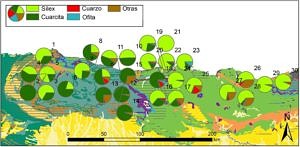Procurement and management of quartzite in the Cantabrian Region: The Middle and Upper Palaeolithic in the Deva, Cares and Güeña Valleys
A project by Dr. Alejandro Prieto
The main aim of this recently finished research project was to understand the acquisition, distribution and management mechanisms implemented by Palaeolithic societies in the Cantabrian Region in order to exploit quartzite as a raw material. Due to the scarcity of previous research on the properties of this raw material, we characterised quartzite from the geo-archaeological point of view in this Region.
The methodology proposed combine three different approaches: microscopic, macroscopic and regional scales. The first one is based on petrographic, geochemical and binocular characterisation. The second one is the macroscopic approach and it is founded on the analysis of lithic assemblages based on technological, typological, petrological and metric criteria. The same macroscopic approach was used to characterise potential raw material acquisition areas through the geological survey of the geological strata and deposits where quartzites are present. Finally, the regional scale methodology is based on the geographic, geologic and archaeological analysis of landscape using Geographic Information Systems.

The application of this comprehensive methodology to a narrow area, the Deva, Cares and Güeña valleys, allowed us to understand quartzite from geological and archaeological perspectives. On one hand, we were able to understand the original source area of the sediment which formed quartzites, their transformations due to sedimentary and metamorphic forces, and the embedded minerals incorporated from the different geological environments where quartzites have been. The understanding of all these phenomena allows us to classify quartzite into seven petrogenetic types and varieties, according to grain size and mineral inclusions. We also describe the geological strata where quartzite is present, characterising both their arrangement and its dispersion based on the types and varieties defined.
On the other hand, we inferred the acquisition, management, and mobility patterns of Prehistoric societies in the Deva, Cares and Güeña valleys during the Middle and Upper Palaeolithic based on the analysis of the lithic assemblages from layers XI, XIII and XXII from El Esquilleu rockshelter, layer Co.B.6 from Coimbre cave, the sites of El Habario and El Arteu and the Cave Art of La Covaciella. This allowed us to understand the different strategies of landscape management of such heterogeneous and mountainous area is.
